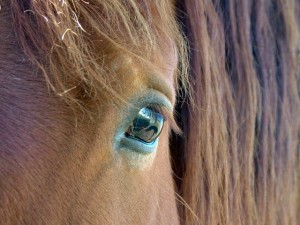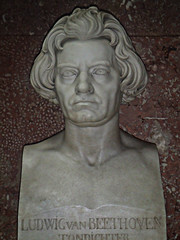ROAD LESS TRAVELED by Robert Frost
Two roads diverged in a yellow wood
And sorry I could not travel both
And be one traveler, long I stood
And looked down one as far as I could
To where it bent in the undergrowth
Then took the other as just as fair
And having perhaps the better claim
Because it was grassy and wanted wear
Though as for that, the passing there
Had worn them really about the same
And both that morning equally lay
In leaves no step had trodden black
Oh, I kept the first for another day!
Yet, knowing how way leads onto way
I doubted if I should ever come back
I shall be telling this with a sigh
Somewhere ages and ages hence
Two roads diverged in a wood
And I took the one less traveled by
And that has made all the difference
continue reading »
 To me, it always seems like there are times when we want change, and times when we don’t, and yet often those two timeframes coincide more than we think. As a child I used to get terribly frustrated with the local news anchors who would complain to the weatherman, “Larry, when is it going to warm up for spring?” And it seemed like not two weeks later those same anchors would say, “Larry, it’s too hot! When is it going to cool down?” The weather is just one thing that isn’t predictable, and I suppose that is where sayings arise such as, “The only sure things in life are death and taxes.” But, there must be more than death and taxes, mustn’t there? As humans, we are fascinated with the loss and gain of things. All the way back to Greece there were plays and now we have movies of course, mostly concerned with the loss and gain of love, fortune, life, health, soul- you name it, you can find an audience who is interested in knowing whether it is lost or gained. And, the reason we are so curious is because the struggle is something we all face, and so the watching of the saga unfold time and time again somehow doesn’t get old.
To me, it always seems like there are times when we want change, and times when we don’t, and yet often those two timeframes coincide more than we think. As a child I used to get terribly frustrated with the local news anchors who would complain to the weatherman, “Larry, when is it going to warm up for spring?” And it seemed like not two weeks later those same anchors would say, “Larry, it’s too hot! When is it going to cool down?” The weather is just one thing that isn’t predictable, and I suppose that is where sayings arise such as, “The only sure things in life are death and taxes.” But, there must be more than death and taxes, mustn’t there? As humans, we are fascinated with the loss and gain of things. All the way back to Greece there were plays and now we have movies of course, mostly concerned with the loss and gain of love, fortune, life, health, soul- you name it, you can find an audience who is interested in knowing whether it is lost or gained. And, the reason we are so curious is because the struggle is something we all face, and so the watching of the saga unfold time and time again somehow doesn’t get old.
continue reading »
Where does that inner wellspring of creativity live and how can one touch it? In continuing on with our interview of Dr. Allen Bishop, I’d like to discuss his views of how music can become a way for getting in touch with one’s internal essence, or beauty.
Dr. Bishop stated about the way children develop through music and art offerings in school, “mainly it’s a vehicle for developing your interiority, and not your external, social, compliant self.”
He explained his views on how music can be therapeutic personally by giving the example of Beethoven’s transformation. “I’ve used music as a therapeutic modality for myself at different points in my life. I use Beethoven as a model of an individual who has triumphed over adversity and some limitations. Also an individual who shows us that, as Bion says, is always possible to bring beauty to difficult circumstances. Beethoven brought the energy of his deafness in 1802 in the midst of suicide and depression, to reinvent himself. As a composer and musician, his greatest music emerged out of that struggle. I think he points to a kind of a psychology based on a certain kind of acceptance, or what he would call, resignation. He had to resign himself to this loss. Once he could do that, then all the energy was freed and came back in this beautiful way. I think that’s what human beings have to do.”
continue reading »
As Rashin mentioned, we recently interviewed Dr. Allen Bishop, who is one of our professors at Pacifica Graduate Institute, as well as a musician. Further in the interview (from what is written in Rashin’s post last week), we discussed the archetypal qualities of music. By using the term archetypal in this way, we’re talking about things are universal in human experience- not only across cultures, but also across time. Jung used the archetype term to describe a pattern of human experience that is consistent. For example, there are some events like love, loss, birth, death that we all experience at some point. When we experience these events, we feel a connection to a larger human realm. For example, new mothers often report a feeling of being connected to all mothers, to motherhood, to the Great Mother, Mother Earth, etc. In Jungian psychology, we call this the mother archetype and regardless of gender, each human will typically have an experience of it.
With Dr. Bishop we discussed how music can be a form of an invitation to that archetypal, mysterious experience that somehow invokes a desire for connection, and yet it is difficult to articulate why this is so. We discussed how in making music, composers create a gateway to this experience. In our discussion we started talking about those pieces of music that transcend time, and wondering about the composers who created them. continue reading »
|
Posted by
Brenda |
Categories:
Culture & Psychology |
With all this talk of Spring Cleaning, I just would rather hibernate. I think bears have a good idea to skip the whole winter wonderland and just sleep for months at a time. Can you imagine eating so much that you wouldn’t need to eat for a few MONTHS? What an amazing process.
In some sense, the bear’s symbol is related to Artemis, the Goddess of the Moon. As such, the bear is associated with lunar qualities, and as a result of its magnificent strength and lethal capabilities, Carl Jung connects the symbol of the bear with the dangerous side of the unconscious. Note: these symbol associations are from the Penguin Dictionary of Symbols. continue reading »
The other day I was riding a bus in San Francisco. I am a tourist, but I try to fit in and belong in the “big city.” To do so, I have become hyper-aware of the rules and I try to follow them, all. Like many public transit systems, younger riders are expected to make way for elder riders, when necessary. On the SF buses, this rule is posted everywhere, and every few stops there is an automated reminder that repeats over the speaker system. On this day, an elderly gentleman boarded the bus after me. He looked at me, and I froze. Although there was a seat available to my left and to my right, I moved over one seat to allow him to take the seat closest the door through which he was entering. I don’t know I did this exactly, I was trying to be nice and respectful, I suppose.
He took it as an invitation to start talking to me. He explained how the first time a young woman had done that was fifteen years ago and he yelled at her and wouldn’t take the seat. “These days,” he said, “I’ll take all the nice things people will do for me.” Aside from “oh,” “yes,” and “yeah” I wasn’t really able to say much for the ten minutes he talked to me (or was it at me?) until my stop. Finally, I broke in mid-sentence and wished him a good day as I hopped off the bus. The smell of his stale breath stayed with me for the two blocks I walked to my destination.
In her book Pyschoanalytic Diagnosis, Nancy McWilliams describes narcissists as, “People whose personalities are organized around maintaining their self-esteem by getting affirmation from outside themselves.”
continue reading »
Do you know what it feels like to be seen? That wonderful exchange between you and a gracious friend or loved one, who really steps outside their own experience to see you in yours, do you know what I mean?
One of my teachers at one of my programs, James Flaherty, asked me an intense question once. He asked, have you noticed how many people in our world are doing out of the ordinary things, just for the sake of being seen? His examples were about recent Olympians who had felt like if they didn’t win gold, all would be for not. And, I extended this notion, what about people who misbehave? For example, sometimes criminals seem to me to be just acting out for the attention they perhaps did not receive as a child. What about the loud, obnoxious person in a restaurant, about which we always say, “Oh, ignore him, he just wants attention.” Yes! That’s exactly what he wants, and perhaps a question we could ask ourselves is why someone needs attention so badly that they must act in uncomfortable or inappropriate ways to receive it. continue reading »
As a student of depth psychology, I study lots of different mental disorders. I have often joked with my fellow students about my tendency to  self-diagnose in every class, seeing a bit of myself in each of the “disorders” as we learn about them. This got me to thinking, what if we stopped labeling ourselves and each other with these very limiting terms?
self-diagnose in every class, seeing a bit of myself in each of the “disorders” as we learn about them. This got me to thinking, what if we stopped labeling ourselves and each other with these very limiting terms?
Disorder: If I look at the breakdown of the word, from the Classical Latin, it is a combination of two ideas: dis- “take away” + ordinare “to order, regulate.”
From the perspective of mental disorders, this could be thought of as, the “taking away” of one’s ability to mentally “order, or regulate.” So, without an ability to mentally regulate, one many experience a mental disorder.
In our world where clinical symptoms are rattled off as fast as is humanly possible during each TV commercial break, medical terminology is entering our everyday language. How many times have you heard the phrases, “She’s bipolar!” or “What a narcissist!”?
With the root of the word “disorder” in mind, it became clear to me that a person in fact is not their mental disorder. We are each so much more. All joking aside, I have experienced many of the disorders about which I read. There have certainly been times of depression, and narcissism, and neuroticism, and the list goes on. Each time, I have been able to “restore order” for myself, in other words, they were temporary states of being for me, they were not “me.” continue reading »
 I have recently started reading the book: Shambhala: The Sacred Path of the Warrior, described as a “practical guide for enlightened living.” In it, author Trungpa talks about breaking old habitual patterns. He says that calling someone a toranoko- a Japanese term for tiger cub, used pejoratively is saying this “you mean that he is a paper tiger, someone who appears brave but is actually a coward.” And Trungpa then makes the declaration, “That is the description of clinging to habitual patterns.”
I have recently started reading the book: Shambhala: The Sacred Path of the Warrior, described as a “practical guide for enlightened living.” In it, author Trungpa talks about breaking old habitual patterns. He says that calling someone a toranoko- a Japanese term for tiger cub, used pejoratively is saying this “you mean that he is a paper tiger, someone who appears brave but is actually a coward.” And Trungpa then makes the declaration, “That is the description of clinging to habitual patterns.”
Likely, most of us aspire to be more like real, living tigers rather than paper ones, so why all the focus on not clinging to habitual patterns?
Thinking about what a habitual pattern is, I realized there is a neurological aspect occurring simultaneous to the display of the habit. In our brains, after we pass the age of three, we are mature enough to start making neural connections based on experience. Up to that point, our Limbic System is primarily driving our behavior. The Limbic System encompasses the functions we share with the animal kingdom, including such things as our “fight or flight” responses, our capacity for infatuation, as well as our process to store memories as pictures (as we mature we include narrative with memory). continue reading »
As the month of February takes off…the topic of connection is at hand. But, how about going beyond our connection to each other, and exploring our connection to the animal realm? Winston Churchill once said, “There is something about the outside of a horse that is good for the inside of a (hu)man.” What is it about this quote that seems to resonate with people who spend time with horses, either for work or pleasure purposes?
The emerging field of Equine Assisted Psychotherapy is proceeding, whether or not the answer to the above question is clear. EAP is psychotherapy with the addition of a horse, or in some cases a group of horses. In an EAP session, there is a participant, a psychotherapist, a horse specialist, and a horse. The participant interacts with the horse with the support of the psychotherapist, and the assistance and safety assurance of the horse specialist. The incorporation of horses into therapy provides an experiential opportunity for healing that goes beyond traditional methods. Both the psychotherapist and horse specialist must have specific training in EAP. Since its founding in 1999, the Equine Assisted Growth and Learning Association, an international non-profit providing EAP training, has granted over 3,000 certifications.
What’s going on here?
The unique human connection to horses is documented as far back as ancient Greece, by Greek historian and philosophical essayist, Xenophon. Born in Athens around 430 B.C.E. Xenophon was studying the way the relationship between horse and rider can be an expression of the archetype of Beauty. In her book, Dressage in the Fourth Dimension, author Sherry Ackerman, explains Xenophon’s view this way, “The ancient teaching held that Beauty was expressed by harmony which was born of perfect balance. The body, mind and spirit of the rider were to attain this integrated state of balance…a harmonious partnership between horse and rider, which expressed itself in Beauty.”
continue reading »

 To me, it always seems like there are times when we want change, and times when we don’t, and yet often those two timeframes coincide more than we think. As a child I used to get terribly frustrated with the local news anchors who would complain to the weatherman, “Larry, when is it going to warm up for spring?” And it seemed like not two weeks later those same anchors would say, “Larry, it’s too hot! When is it going to cool down?” The weather is just one thing that isn’t predictable, and I suppose that is where sayings arise such as, “The only sure things in life are death and taxes.” But, there must be more than death and taxes, mustn’t there? As humans, we are fascinated with the loss and gain of things. All the way back to Greece there were plays and now we have movies of course, mostly concerned with the loss and gain of love, fortune, life, health, soul- you name it, you can find an audience who is interested in knowing whether it is lost or gained. And, the reason we are so curious is because the struggle is something we all face, and so the watching of the saga unfold time and time again somehow doesn’t get old.
To me, it always seems like there are times when we want change, and times when we don’t, and yet often those two timeframes coincide more than we think. As a child I used to get terribly frustrated with the local news anchors who would complain to the weatherman, “Larry, when is it going to warm up for spring?” And it seemed like not two weeks later those same anchors would say, “Larry, it’s too hot! When is it going to cool down?” The weather is just one thing that isn’t predictable, and I suppose that is where sayings arise such as, “The only sure things in life are death and taxes.” But, there must be more than death and taxes, mustn’t there? As humans, we are fascinated with the loss and gain of things. All the way back to Greece there were plays and now we have movies of course, mostly concerned with the loss and gain of love, fortune, life, health, soul- you name it, you can find an audience who is interested in knowing whether it is lost or gained. And, the reason we are so curious is because the struggle is something we all face, and so the watching of the saga unfold time and time again somehow doesn’t get old.






